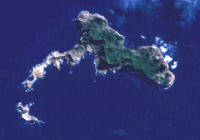Santa Clara Island facts for kids
|
Native name:
Isla Santa Clara
|
|
|---|---|

Map showing tiny Santa Clara at bottom left
|
|
| Geography | |
| Location | Pacific Ocean |
| Coordinates | 33°42′25″S 78°56′29″W / 33.70694°S 78.94139°W |
| Type | Shield Volcanoes |
| Archipelago | Juan Fernández Islands |
| Area | 2.2 km2 (0.85 sq mi) |
| Highest elevation | 376 m (1,234 ft) |
| Highest point | Johow Hill |
| Administration | |
| Demographics | |
| Population | Uninhabited |
Santa Clara Island, or Isla Santa Clara in Spanish, is a small, empty island in the Pacific Ocean. It's part of the Juan Fernández Islands, located near Robinson Crusoe Island. This island was formed by a volcano. It's about 1 kilometer (0.6 miles) long and 0.6 kilometers (0.4 miles) wide. Santa Clara Island belongs to Chile, a country in South America. It's managed by the Valparaíso Region.
Contents
Geography of Santa Clara Island
Santa Clara is the smallest island in the Juan Fernández group. It covers an area of about 2.2 square kilometers (0.85 square miles). A reef surrounds its southern side. This small volcanic island is connected to two other islands. It lies about 1.5 kilometers (0.9 miles) southwest of Robinson Crusoe Island.
Island Features and Formation
Santa Clara Island has a mostly flat surface. Its highest point is Johow Hill, which is 376 meters (1,234 feet) tall. Scientists believe Santa Clara is the oldest volcano in the group. It likely formed about 5.8 million years ago. This makes it much older than Robinson Crusoe Island.
The island has volcanic rocks and several small beaches. Some of these beaches have white sand. Near the western end of Santa Clara, there is a small rocky islet. A sandbar made of rocks is located south of this islet. When you approach Santa Clara from the north, it looks like a tall cliff. But from the south, it appears eroded with strange conical mounds and oddly shaped rocks.
Ocean Around the Island
The water around Santa Clara Island has a rocky bottom. There are also strong ocean currents. It can be dangerous to reach the island by boat. This is especially true during storms. The strong waves break on all sides of the island.
Climate of Santa Clara Island
Santa Clara Island is not very high above sea level. Because of this, it doesn't get much rain. The amount of rain also changes depending on the El Niño-Southern Oscillation. The island has a subtropical climate. This means it's usually warm.
Weather Patterns
The climate is greatly affected by the cold Humboldt current in the ocean. It's also influenced by the southeast trade winds. These winds bring more rain in winter and less in summer. They also help keep the temperature steady. Temperatures on the island range from 3°C (37°F) to 34°C (93°F) throughout the year. The average temperature is about 15.4°C (59.7°F).
Plants and Animals of Santa Clara Island
Santa Clara Island generally looks empty and dry. However, there are some trees on its eastern side. A stream of water flows along a gorge on the northwest tip. This stream reaches the sea during certain times of the year.
Challenges for Island Life
In the past, herds of goats ate much of the low-lying plants. The native plants on the island don't handle fire well. They also struggle to resist animals that eat them. Wild rabbits are a big threat to the island's habitats. They cause a lot of damage to the plants.
Most of the original plants on the island have been replaced. Now, you'll mostly find shrubs and grasses. The plant life is a mix of different types. There are dry shrubs, bare rocks, trees of various sizes, and ferns. Many parts of Santa Clara are full of introduced plants. These include Rubus ulmifolius, Aristotelia chilensis, Ugni molinae, Lantana camara, and Lonicera japonica. Some of these plants can become serious problems. They have fruits that birds spread. There are also weeds like Danthonia collina, Stipa laevissima, and Piptochaetium bicolor.
Wildlife and Conservation
There are no permanent sources of fresh water on Santa Clara Island. Birds are the main animals living on the islet. Some of these birds are endangered. They build their nests on the island or visit it. Santa Clara Island, along with nearby Robinson Crusoe Island, is recognized as an Important Bird Area (IBA). This means it's a very important place for bird conservation.
Government and Economy
Santa Clara is an uninhabited island. It is part of a larger area in the Valparaíso Region of Chile. Easter Island is also managed from this region. The main ways people make money in this area are by fishing for spiny lobster (Jasus frontalis) and through tourism. The entire group of islands has been a nature reserve since 1977. It is called the Archipiélago de Juan Fernández National Park.
See also
 In Spanish: Isla Santa Clara (Chile) para niños
In Spanish: Isla Santa Clara (Chile) para niños


